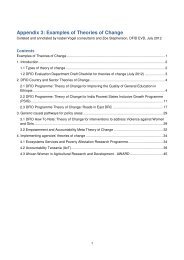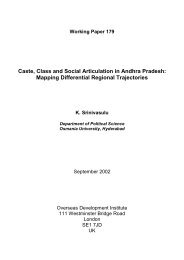Full Report - Research for Development - Department for ...
Full Report - Research for Development - Department for ...
Full Report - Research for Development - Department for ...
You also want an ePaper? Increase the reach of your titles
YUMPU automatically turns print PDFs into web optimized ePapers that Google loves.
Synthesis results<br />
government administration, regional or national levels, and as such include rural and<br />
urban populations.<br />
One study focused entirely on an urban population (Bashir et al., 1995) (-)/(-). A<br />
combination of low-cost services or free services <strong>for</strong> deserving cases, obstetric flying<br />
squad services, training <strong>for</strong> TBAs, antenatal check-ups and intensive community<br />
education had a positive impact on maternal mortality levels in a major city in<br />
Pakistan. A key to the uptake and success of services such as the flying squad was<br />
the community events and radio education campaigns highlighting their availability.<br />
Three studies published over the last decade focused on evaluation of Safe<br />
Motherhood or Mother Care interventions as a whole. These complex programmes<br />
involved many different types of interventions which present particular challenges<br />
<strong>for</strong> evaluation. Studies in Egypt and Tanzania assessed the impact of national<br />
programmes on maternal mortality, and found that reductions in mortality over time<br />
were evident (Mbaruku and Bergstrom (1995) (-)/(-); Mswia et al., 2003 (+)/(++);<br />
Alwen et al., 2005 (-)/(+); Campbell et al., 2005 (+)/(+)), although attributing<br />
causality was poor. In Nigeria, Okaro et al. (2001) (-)/(-) showed that the Safe<br />
Motherhood Initiative had not succeeded, with the MMR increasing fivefold since its<br />
start. This was attributed to a deterioration in general living standards which had<br />
wiped out any improvements due to better maternal health care. This highlights that<br />
health sector investment alone is unlikely to reduce maternal deaths.<br />
Two further studies have considered how interventions at a national or state level<br />
may have contributed to declining maternal mortality over time. Padmanaban et al.<br />
(2009) (-)/(+) outlined the interventions that were judged to have contributed to the<br />
significant decrease in maternal mortality in the Indian state of Tamil Nadu. The<br />
MMR in the state reduced from 380 to 90 per 100,000 live births in the period from<br />
1993 to 2007. The paper drew on the observations of the authors, based within the<br />
Ministry of Health and Family Welfare, as well as secondary data and literature<br />
where available. The paper described wide-ranging interventions from improvements<br />
in availability of human resources; availability of key drugs, blood and supplies;<br />
improved management capacity; and better surveillance and analysis of maternal<br />
deaths. It is not possible from the paper to quantify the effect of the interventions<br />
directly but it does highlight the importance of political will and leadership, and<br />
engagement of directorates across governments, not just health. For China, Yan<br />
(1989) (-)/(-) showed how improved training and services under a national<br />
programme had helped to reduce maternal mortality in the country since the 1950s.<br />
Starting with training of TBAs, then with referral systems in 1952, up to recruitment<br />
and training of midwives and obstetricians alongside TBAs, the Chinese MMRs<br />
declined sharply in the 1950s and 1960s. However, no specific reference is made in<br />
this study to specific interventions in poor urban areas.<br />
4.1.6 Complex interventions: infant mortality outcomes<br />
Only three papers focused on complex interventions <strong>for</strong> infant mortality (Appendix<br />
4.6). Section 4.1.5 showed that the complex interventions <strong>for</strong> maternal mortality<br />
focused mainly on national or large scale programmes. Two of the complex<br />
interventions <strong>for</strong> infant mortality focused more closely on addressing a specific area<br />
of clinical care through a package of interventions. The areas of focus were special<br />
care <strong>for</strong> infants (Borulkar et al., 1998) (-)/(-) and management <strong>for</strong> mothers with<br />
diabetes during pregnancy and labour (Mirghani and Saeed, 2000) (-)/(-).<br />
The study by Borulkar et al. (1998) (-)/(-) in India reported on the development of a<br />
model <strong>for</strong> the special care of newborns at a community hospital in a predominantly<br />
tribal block in an urban area. The key interventions included: adequate warmth;<br />
prompt resuscitation; proper feeding; and oxygen administration when necessary.<br />
What are the effects of different models of delivery <strong>for</strong> improving maternal and infant health<br />
outcomes <strong>for</strong> poor people in urban areas in low income and lower middle income countries? 39









